Abstract
Climate change education is crucial for fostering informed and engaged future generations. However, traditional pedagogies often fail to engage learners fully and provide real-world, experiential learning. This paper presents a novel approach to climate change education through a three-day virtual reality (VR) hackathon. The hackathon focused on four United Nations (UN) Sustainable Development Goals (SDGs)—Quality Education, Affordable and Clean Energy, Sustainable Cities and Communities, and Climate Action. Using VR technology and game design software, engineering students worked in teams. They competed against each other in designing immersive environments that demonstrated their understanding of these SDGs and climate change. Our goal was to encourage the development of empathy, education, and awareness around these critical global issues. The hackathon also integrated authentic assessments, mirroring real-world engineering tasks and providing a more practical and relevant learning experience. Our findings suggest that this VR hackathon has significantly enhanced students’ understanding of the SDGs and climate change issues, their competency with VR technologies, as well as their teamwork and problem-solving skills. This paper discusses the hackathon’s design, implementation, and outcomes, highlighting the potential of such innovative approaches in tackling climate change education and awareness.
1. Introduction
Tackling some of the world’s toughest environmental challenges requires widening the scope of education and training to accelerate our energy transition to zero carbon by 2050 [1]. Moreover, reducing our carbon emissions will help limit the effects of climate change [2]. In fact, replacing fossil fuels with renewable energy can potentially achieve 90% of the required carbon reductions [3]. However, the traditional methods of teaching and training students in renewable energy system design have been significantly hampered by COVID-19 social distancing restrictions, which have made it challenging for students to gain practical, hands-on experience [4]. To address this challenge, this study explored the effectiveness of a constructionist-based learning approach [5,6]. Students were encouraged to use virtual and augmented reality (VR/AR) technology to build their own immersive virtual environments. This facilitated easier, safer, and faster visualisation and understanding of climate change’s impact and how renewable energy systems can mitigate it.
Our preliminary findings using virtual reality (VR) for teaching solar energy system design have already shown a positive student experience [7]. Our motivation was to develop a curricular innovation in teaching renewable energy technologies using modern technology tools as a compelling offering for tackling climate change issues.
The literature suggests that VR and augmented reality (AR) training enhances the user’s intrinsic motivation, which improves their learning and performance when transferring skills from the virtual environment to the real world [8]. This risk-tolerant learning environment can be transformative for design learning [9]. Additionally, creating a learning space where students can transfer theoretical information to tackle real-world challenges enables educators to develop skills in teamwork, communication, and problem-solving among students [10]. Moreover, the literature suggests that immersive environments create a much more stimulating learning experience since students become active participants, rather than bystanders in the learning process [11,12]. Furthermore, VR/AR can expose students to new experiences that would otherwise be impossible, costly, or dangerous [13,14]. For example, students would not be able to accelerate time to witness rising sea levels in coastal cities like Alexandria [15], a consequence of greenhouse gas (GHG) emissions linked to climate change [16], nor could they experience the heat-trapping effect of burning diesel fuel in the atmosphere [17]. Therefore, immersive VR and AR can deliver meaningful climate change content and test how students think and respond to these issues, particularly given the complexity and abstract nature of climate and environmental changes [18,19]. One major barrier to tackling climate change is the perception that it is a distant threat, unconnected to people’s daily lives. This psychological distance often leads to a sense of detachment [19,20], whereas VR allows users to visualise information and future scenarios.
Therefore, our student-centred teaching intervention aimed to achieve its objectives by inviting penultimate-year engineering and computer science students to participate in a 3-day hackathon to raise empathy, education and awareness around four UN SDGs (depicted in the concept image shown in Figure 1. Evidence suggests that these programmes offer students an opportunity to forge relationships with new staff/students and to gain new skills [21]. The term “hackathon” combines the words “hack” and “marathon” and denotes an extended, focused time spent developing a project [22]. Hackathons have been used as an educational tool to help students learn social skills, such as teamwork and collaboration, or to raise students’ curiosity about learning new things [23]. Educational hackathons provide an informal setting to enhance the learning experience. Depending on the learning objectives, these hackathons might provide varying formats and durations [24].
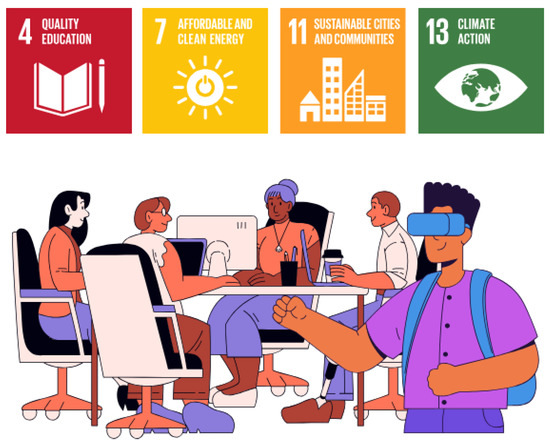
Figure 1.
Conceptual illustration of virtual reality (VR) being used in a collaborative environment for raising empathy, education and awareness around four UN SDGs.
During the hackathon, participating students compete against each other in developing VR applications to help raise awareness, empathy, and education around climate change. Our teaching intervention aimed to give students the opportunity to improve their technical understanding of renewable energy technologies that can effectively counterbalance the negative impact of climate change, as well as improve the sustainability of their local communities. Another motivation was to give students opportunities to develop their digital literacy skills, as well as critical soft skills that include teamwork and collaboration—all of which will help prepare the next generation of students tackle global climate change issues.
The intended learning outcomes (ILOs) of our teaching activity were twofold:
- Understanding and application of the UN’s Sustainable Development Goals (SDGs) [25]: By the end of the intervention, students will demonstrate a comprehensive understanding of the selected UN SDGs and the associated climate change issues. They will be able to apply these concepts to analyse real-world environmental problems and propose sustainable solutions, thereby showing their readiness to contribute meaningfully to the field of climate change and sustainability.
- Proficiency in VR/AR technologies: Students will acquire proficiency in using VR/AR technologies as tools for learning and problem-solving. They will demonstrate the ability to effectively use these technologies to create immersive experiences, model complex systems, and visualise solutions. This proficiency will prepare them for future roles in technology-driven fields and give them a competitive edge in the job market.
2. Background and Motivation
Empirical evidence of the effectiveness of VR in changing environmental attitudes has been reported in the literature [26,27]. For example, Markowitz et al. in [28] assessed the effectiveness of an immersive VR environment as a teaching tool to elucidate climate change effects, particularly ocean acidification. The findings of one experiment of this study confirmed the potential of immersive VR in fostering knowledge about important social issues and showed a positive environmental attitude of students. Fonseca and Kraus in [29] conducted a study to examine the effects on the environmental attitude and behaviour of the narrative content and immersion level. According to the findings, the degree of immersion raised the viewers’ emotional response and pro-environmental attitude.
Therefore, below are the systematic research questions (RQs) and hypotheses (Hs) that were formulated to guide our study:
- Research Question 1 (learning effectiveness): How does the integration of VR/AR technology in a constructionist learning environment, specifically within the context of a VR hackathon, enhance students’ comprehension and application of the selected UN SDGs? How does this innovative approach influence their capacity to address real-world climate change challenges?
- -
- Hypothesis 1 (learning effectiveness).The immersive, hands-on approach of the VR hackathon will significantly improve participants’ understanding and knowledge of the four selected UN SDGs and climate change issues compared to traditional classroom-based learning methods.
- Research Question 2 (technology familiarity): How does the VR hackathon experience influence students’ proficiency and comfort with VR/AR technologies? How does this immersive learning context impact their preparedness for future technologically oriented roles?
- -
- Hypothesis 2 (technology familiarity).Participation in the VR hackathon will significantly increase students’ familiarity and competence with VR/AR technologies, thereby enhancing their preparedness for future technological roles in their respective fields.
- Research Question 3 (teamwork and collaboration): How does the team-based collaborative nature of the VR hackathon contribute to the development of students’ teamwork and problem-solving skills, and how does this prepare them more effectively for real-world engineering scenarios? Does it enhance their ability to work collaboratively and effectively as a team?
- -
- Hypothesis 3(teamwork and collaboration). The collaborative nature of the VR hackathon will significantly enhance participants’ teamwork and problem-solving skills, preparing them more effectively for real-world engineering scenarios. Moreover, the metaverse breaks down barriers and enables learners to work together in teams.
- Research Question 4 (authentic assessments): How do students perceive the authentic assessments used in the VR hackathon in terms of reflecting real-world engineering scenarios and measuring understanding and skill application compared to traditional assessment methods?
- -
- Hypothesis 4(authentic assessments). The authentic assessments used in the VR hackathon (developing an app that raises empathy, education, and awareness around 1 of 4 SDGs) will be viewed as significantly more reflective of real-world engineering scenarios and effective in measuring understanding and skill application compared to traditional assessment methods.
- Research Question 5 (overall experience): How do students rate their overall experience of participating in the VR hackathon compared to traditional classroom-based learning experiences, and what factors contribute to higher student engagement and motivation?
- -
- Hypothesis 5(overall experience). The overall experience of participating in the VR hackathon will be rated significantly higher by students compared to traditional classroom-based learning experiences, leading to higher student engagement and motivation.
These questions were investigated using mixed research methods consisting of surveys and interviews. Our research aimed to inform how the use of VR/AR technology in raising awareness around the UN’s SDGs can be scaled up and integrated into broader educational programmes to enhance the impact of this innovative pedagogical approach.
3. Teaching Approach and Delivery
Our innovative approach to teaching and delivery involved organising a three-day immersive hackathon in Cairo (as shown in Figure 2), incorporating team-based learning (TBL) [30] and authentic assessments to respond to demands from engineering accreditation bodies. This hackathon aimed to raise awareness around four key UN SDGs: SDG 4 (Quality Education), SDG 7 (Affordable and Clean Energy), SDG 11 (Sustainable Cities and Communities), and SDG 13 (Climate Action).
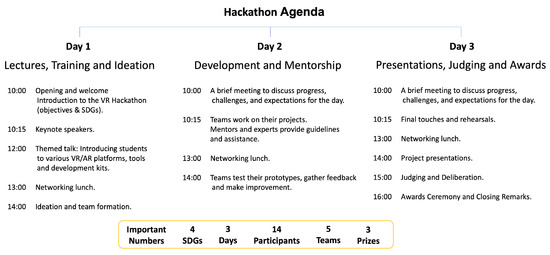
Figure 2.
The 3-day schedule for the VR hackathon.
Assessing and evaluating the impact of VR/AR technology in climate change education has been explored through various techniques in the literature. For example, pre and post tests were used to measure students acquiring knowledge and information retention. Also, questionnaires can be used to gather students’ feedback regarding their experience using VR/AR regarding their engagement, satisfaction, and effectiveness. Moreover, qualitative data from interviews or focus groups can provide rich insights into the impact of using these technologies towards climate change and renewable energy education. To comprehensively evaluate the effectiveness of integrating VR/AR, we used a combination of these methods, as detailed in Section 4 and Section 5.
For delivery, on the inaugural day, we began with an opening ceremony introducing the purpose of the hackathon and keynote speeches by two renowned experts in Africa discussing the interplay of VR/AR and artificial intelligence (AI). Following these keynotes, participants engaged in workshops on various VR/AR tools and platforms to equip them with the necessary skills. The day continued with two lightning talks by industry professionals shedding light on the interconnection of the selected SDGs with VR/AR technologies. The afternoon was dedicated to team formations, where participants pitched their ideas and formed teams, later spending the remainder of the day refining their concepts and planning their projects. The second day was primarily dedicated to hacking and development. We organised check-in sessions each morning and evening to monitor progress and address any challenges encountered by the teams. The third day followed a similar pattern, with the majority of the day spent on project development. The latter part of the day focused on prototype testing and iterative improvements.
The final day of the hackathon saw teams putting the finishing touches on their projects and rehearsing their presentations. After a networking lunch, teams presented their VR/AR experiences to the judges and audience, who evaluated projects based on innovation, impact, relevance to the selected SDGs, and technical achievement. The event concluded with an awards ceremony, where winning teams were recognised for their exceptional work. Figure 2 demonstrates the VR hackathon agenda during the three days.
4. Methodology
Recruiting the right participants was crucial to the hackathon’s success. Students from science and engineering disciplines were invited to apply through a form, providing their names, emails, and reasons for interest in the VR hackathon, followed by their CVs. A flyer was distributed to all undergraduate students through social media. Specifically, we targeted students from interdisciplinary backgrounds including computer science, computer engineering, information and computer systems, mechanical engineering, and renewable energy. Our goal was to ensure that students with complementary backgrounds could team up to develop creative VR solutions. By inviting students from diverse areas with skills in programming, design, and engineering, we aimed to foster the creation of innovative VR projects.
Out of 36 interested students who submitted applications and motivation letters, 22 were shortlisted based on their technical skills for VR development, including proficiency in programming languages. Additionally, commitment to attending the entire duration of the hackathon was considered. Finally, the motivation letters helped identify participants with a genuine passion for VR technology and a strong interest in tackling climate change. This resulted in the selection of 14 participants.
The selected students were divided into five groups, each advised by a senior graduate teaching assistant. Additionally, three academic staff members oversaw the project. To develop their applications during the 3-day hackathon, students were grouped into teams of 3 with complementary skills, except for one team with 2 members. Upon satisfactory completion of the hackathon, students received a certificate of completion.
In a boardroom format, a panel of staff members from AUC, UoG, and the British Council judged student presentations, evaluating team designs and awarding VR headsets to the winning application. Each group was also assigned a graduate student who acted as a mentor and provided technical troubleshooting, as well as domain-related content assistance in building their virtual worlds. On the last day of the hackathon, students showcased their designs via a 10 min group oral presentation.
A series of questions were designed to assess each presentation based on three key criteria: clarity and organization, understanding and application of the SDGs, and use of VR/AR technology. The HTC Vive and Meta Quest 2 VR headsets were offered to students during the hackathon. Moreover, during the hackathon, game engines such as Unity and Unreal were used by the participants for developing and creating their VR applications.
5. Survey Design
Based on the approach outlined in [10], our evaluation of this teaching activity involved securing participant consent beforehand. Students were assured of the voluntary nature of their involvement and the anonymity and confidentiality of the data collected. They were also advised that their participation could be withdraw whenever they wished.
Questionnaire Design
An online survey with 23 questions was designed and distributed to gather student feedback regarding the effectiveness of this teaching approach, as shown in Table 1. These questions were divided into five Parts to measure the five research questions and hypotheses. The first five questions in Part 1 were designed to collect student opinions regarding their understanding of the UN’s SDGs and their overall awareness of climate change issues (RQ1). Students were invited to indicate their learning experience via a 5-point Likert scale ranging from 1 (disagree entirely) to 5 (agree entirely). Moreover, while open-ended questions can yield rich, qualitative data, they can also be time-consuming for respondents to answer and for researchers to analyse [31,32]. Therefore, we preferred a more structured response and gave students multiple options to choose from. Part 2 of the questionnaire consisted of structured questions asking students to rate the skills they developed throughout the hackathon (RQ2). Part 3 included three questions designed to collect responses about the assessment’s quality (RQ3). Part 4 was focused on collecting insights into the students’ experiences with teamwork (RQ4). Lastly, Part 5 of the survey contained questions aimed at capturing the students’ overall experience during the hackathon (RQ5).

Table 1.
Questions used to assess the effectiveness of our pedagogical approach.
6. Results
Throughout the hackathon, students were given the freedom to develop any kind of project they liked as long as it helped raise awareness regarding one of the stated SDGs. Examples of the student games are illustrated in Figure 3. For example, one of the VR projects was a multiplayer VR game that raised awareness of SDG 7, Affordable and Clean Energy. In each round of the game, players were given a certain budget to invest in any kind of energy: fossil fuel, solar energy, wind energy, etc. Their choices are reflected on the scoreboard, where their goal is to produce the biggest amount of energy while keeping the environmental damage at a minimum. In fact, AUC’s Media Relations Unit helped compile a short video (https://www.youtube.com/watch?v=oByg9jLqu1U, (accessed on 14 March 2024)) demonstrating our teaching process.
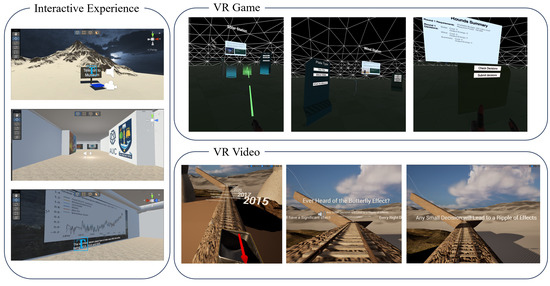
Figure 3.
Snapshots from students’ work during the hackathon. The projects that the students developed were diverse in regard to the output product; some created interactive experiences, some VR games, and some VR videos.
According to the survey of participants during the registration, the majority, 40%, took part in the hackathon to learn about using VR technology and building an application. In addition, 20% of the students were interested in using virtual reality in solving global challenges, while 15% were interested in spreading awareness and environmental concerns to people. Figure 4 demonstrates students’ approaches to participating in the hackathon.
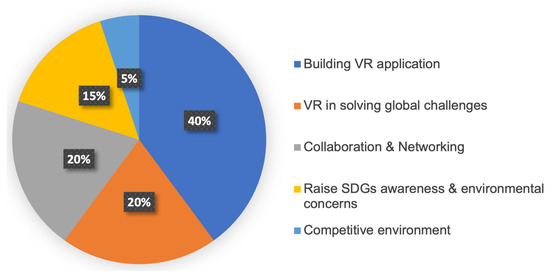
Figure 4.
Distribution of students’ motivations for participating in the virtual reality (VR) hackathon. The chart highlights a range of incentives, with the majority (40%) of participants specifically citing their eagerness to develop a “VR application”. Other reasons included using “VR for solving global challenges” and for networking opportunities.
6.1. RQ1: Learning Effectiveness
The first two questions in the survey were about rating the participants’ understanding and comprehension of the four SDGs before and after the hackathon. The results showed a significant improvement in the SDGs’ understanding after the hackathon as 63.6% of the students rated 5 “Excellent” and 27.3% rated 4 after the hackathon. Figure 5A demonstrates the notable improvement after participating in the VR hackathon.
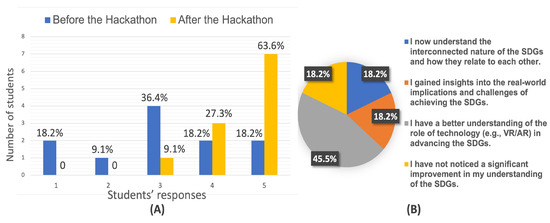
Figure 5.
(A) Students’ understanding of the SDGs, as measured on a scale of 1 (very poor) to 5 (excellent) after taking part in the 3-day hackathon. The pie-chart in (B) demonstrates which areas students saw the greatest improvement in as a result of participating in the hackathon.
Also, 45.5% of the students rated 5, as extremely effective, and 27.3% rated 4 on how effectively they believed the hackathon had enhanced their understanding of climate change issues. In addition, when asking the participants how confident they felt in explaining the significance of these SDGs to others, after participating in the hackathon, 27.3% rated 5 as extremely confident and 54.5% rated 4.
When asking the participants to select the best option that describes how their understanding of the SDGs has improved as a result of the hackathon, the majority of the students, 45.5%, selected that they had a better understanding of the role of technology (e.g., VR/AR) in advancing the SDGs. Figure 5B shows the results of the participants for this question.
6.2. RQ2: Technology Familiarity
Two questions in the survey were about rating the participants’ familiarity with VR and AR technologies before and after participating in the hackathon. The results in Figure 6 show a noticeable development in how the participants got acquainted with the VR and AR technology in a short time, as the majority of the participants rated 4 (very familiar) and 5 (extremely familiar) for this question.
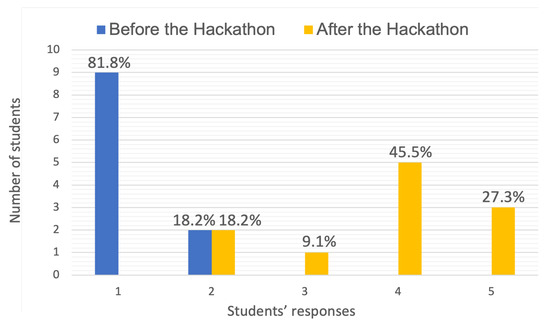
Figure 6.
Students’ rating their familiarity with VR/AR technologies on a scale of 1 (not at all familiar)–5 (extremely familiar) before and after participating in the VR hackathon.
Also, most of the participants (72.7%) rated 5 as strongly agree with the statement: “The Hackathon significantly improved my ability to use VR/AR technologies”. Interestingly, only one participant selected 1 as strongly disagreed with this statement.
When the participants were asked how useful they thought the skills they learned at the hackathon (related to VR/AR technologies) will be in their future studies or career, 54.4% of them rated 4, as it was very useful, while 23.3% rated 5 as extremely useful. No one selected 1 or 2 as the skills they gained at the hackathon were “Not at all” or “Slightly” useful.
There were many questions aimed at measuring the VR skill proficiency rate after participating in the hackathon. The skills were related to the tools and the game engines that were needed for developing a VR application with its assets and animations, the capabilities and limitations of different VR systems, and problem-solving skills.
Table 2 summarises the VR skills gained during the hackathon. Students reported the highest proficiency in “Game Engine Proficiency”, “Testing and Debugging”, and “Problem-solving Skills”, with 36.4% of participants rating themselves as “masters” in each of these skills. The majority (72.7%) rated their proficiency in “Understanding of VR Hardware” as 4 (proficient) or 5 (master). In contrast, 45% of students rated their “3D Modeling and Animation” skills as 1 (minimal proficiency) or 2 (less proficient). No participants mastered “Spatial Audio Design”, while 72.8% rated themselves as 3 (less proficient) or 4 (proficient). Finally, only 36.4% of participants mastered “Programming and Scripting”, with most rating their proficiency as lower.

Table 2.
Participants’ self-reported VR skills gained during the hackathon were measured on a scale of 1 (minimal proficiency) to 5 (mastery), including the mean () and standard deviation ().
According to students’ responses, participants felt most confident in their “Problem-solving Skills” with the highest mean rating of 3.9, indicating a strong perceived improvement in this area. In contrast, “3D Modeling and Animation” received the lowest mean rating of 2.6, suggesting participants felt less proficient in this skill area. Moreover, “User Experience (UX) Design” and “Testing and Debugging” showed higher variability ( ≥ 1.4), indicating a wider spread in the participants’ self-assessed skill levels. Conversely, “Spatial Audio Design” and “Problem-solving Skills” had lower variability, suggesting more agreement among participants about their skill levels in these areas.
6.3. RQ3: Teamwork and Collaboration
The VR hackathon brought together students from diverse backgrounds and skills to work on a VR project. The questionnaire results indicated that the VR hackathon enhanced the participants’ teamwork and problem-solving skills. Figure 7 summarises the main questions used for evaluating the improvement of teamwork after participating in the hackathon.
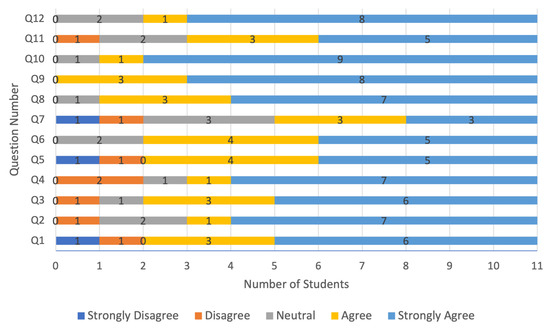
Figure 7.
Students’ responses to the Section 3 survey questions for evaluating the improvement of teamwork and problem-solving skills. The 12 questions were about rating to what extent they agreed with the following statements on a scale of 1 (strongly disagree)-5 (strongly agree). Q1: I share positive opinions about the team’s decision-making ability. Q2: I share positive opinions about the team’s ability to achieve objectives. Q3: I share positive opinions about the team’s ability to motivate each other to complete tasks. Q4: I give my colleagues feedback about their performance. Q5: I ask my colleagues for feedback about my performance. Q6: I collaborate in order for us to coordinate our work. Q7: I ask my colleagues for help when I am unable to finish my part of the work. Q8: I collaborate in redistributing tasks. Q9: I talk to my colleagues in order to establish common objectives for all of us. Q10: I provide solutions for the problem inherent in the task. Q11: I speak openly with my colleagues about team conflicts. Q12: I make sure that what I communicate is understood.
Overall, participants reported positive improvements in teamwork and collaboration after the hackathon. When asked about their team’s decision-making ability, 54.5% strongly agreed it was effective, while 27.3% agreed.
Regarding each team’s ability to achieve objectives, 63.3% strongly agreed, while 18.2% remained neutral. Similar positive responses were found for the team’s ability to motivate each other (54.5% strongly agreed, 27.3% agreed).
Providing feedback to colleagues was also seen as valuable: 63.3% strongly agreed they gave and received feedback, with 36.4% agreeing and 9.1% disagreeing. Integrating learnings from past performances was also positively viewed, with 54.5% strongly agreeing and 45.5% agreeing.
Collaboration in defining goals and coordinating work was also successful: 63.3% strongly agreed they collaborated on the desired results (27.3% agreed, 9.1% neutral), while 45.5% strongly agreed they collaborated on work coordination (36.4% agreed, 18.2% neutral). Recognising teammates’ mistakes was reported positively, with 27.3% strongly agreeing and 45.5% agreeing.
Confidence in real-world teamwork scenarios was high: 54.5% rated themselves “extremely confident”, 36.4% “very confident”, and 9.1% “somewhat confident”. Additionally, 45.4% strongly agreed that the hackathon “significantly enhanced their teamwork skills”; 27.3% agreed, while 18.2% disagreed, and only 9.1% strongly disagreed.
6.4. RQ4: Authentic Assessments
When asking the participants to rate the extent to which the practical assignments, such as project development and presentations, accurately represent scenarios they might encounter in real-world engineering contexts, 27.3% rated 5 as an extremely accurate rate, while ratings 3 and 4 had the same percentage of participants (36.4%). The participants also were required to rate the effectiveness of the authentic assessments in measuring their understanding of the SDGs and their ability to apply VR/AR technologies: 54.4% of the participants rated 4 “Very Effective” and 45.5% rated 5 “Extremely Effective”, while 45.5% strongly agreed with the statement: “The assessments provided valuable feedback on my learning progress”, and 18.2% selected 4 as they agreed with the statement, while 27.3% rated 3 as neither agree nor disagree.
The participants provided examples of how the authentic assessments enhanced their understanding of real-world applications of their learning and were able to choose more than one option. Figure 8 shows the participants’ responses to this question.

Figure 8.
Examples of how the authentic assessments enhanced the participants’ understanding of real-world applications of their learning.
Also, 45.5% of the participants strongly agreed with the statement: “The authentic assessments enhanced my learning experience during the hackathon”, while 27.3% agreed and 18.2% disagreed.
6.5. RQ5: Overall Experience
When asked about their overall experience, most responses were positive, with 45.5% rating 5 and 36.4% rating 4, as shown in Figure 9A. This is further confirmed by Figure 9B, where 10 out of the 11 participants who filled out the survey would recommend this hackathon to other students.
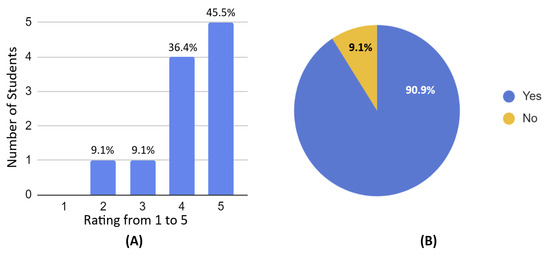
Figure 9.
(A) Participants’ rating, on a scale of 1–5, their overall experience with the hackathon, where 1 is “Very Poor” and 5 is “Excellent”. (B) Whether they will recommend this hackathon to other students.
The participants also shared what they believed were the most beneficial aspects of the hackathon: the introduction to VR technology, hands-on work, the provision of equipment, the mentors’ guidance, and the use of technology to solve real-life problems. However, they also believed that their experience would have been better if they had been provided more training on VR development, as well as more time to develop their projects.
Finally, when asked how their motivation to pursue further learning or career opportunities in the field of VR/AR technology changed, 54.5% stated that their motivation somewhat increased, while 18.2% declared that it significantly increased.
7. Discussions and Further Work
During this investigation, we aimed to understand how integrating virtual and augmented reality (VR/AR) technologies can foster the appreciation of the UN’s Sustainable Development Goals (SDGs) through a hackathon. Our findings offer perspectives on their effectiveness. Participants found the hackathon an engaging activity for collaborative innovation, aligning with research suggesting AR/VR can significantly enhance learning outcomes by reducing cognitive load, increasing engagement, and improving memory recall, especially for complex subjects such as engineering [33,34,35]. However, technical skill acquisition in “3D Modeling and Animation” was challenging within the event’s timeframe, demonstrating the need for prolonged exposure, similar to traditional educational settings [36,37]. Nevertheless, aspects such “Understanding VR Hardware”, “Game Engine Proficiency”, and collaborative “Testing/Debugging” received satisfactory feedback, highlighting the value of immersive learning in fostering practical skills [38]. This suggests that, while VR/AR technologies hold promise for educational innovation, they require strategic integration into traditional teaching curricula to fully harness their potential.
VR hackathons have the potential to provide dynamic platforms encouraging creativity, collaboration, and problem-solving skills among participants, as well as increasing the students’ comprehension of climate change issues and SDGs. The VR hackathon enabled students to immerse in a virtual environment that replicates the effects and consequences of climate change and simulates real-world scenarios related to the selected SDGs. This immersive experience allows users to engage with the objectives in a more tangible and meaningful way. The results of this innovative approach showed a notable improvement in the participants’ technical understanding of VR/AR technologies, which can be seen from the questionnaire results. During the VR hackathon, participants typically worked on practical development tasks. They had the opportunity to improve their technical abilities while coding, troubleshooting, and designing 3D models, emphasising user experience (UX) design.
Also, the VR hackathon provided participants with an opportunity to cultivate and enhance a range of soft skills. For instance, the results showed how the VR hackathon enhanced teamwork and collaboration among participants, fostering the ability to convey ideas and achieve objectives. In fact, improving problem-solving skills leads to critical thinking and overcoming obstacles [39], which indicates that the VR hackathon encouraged creativity and positive thinking and motivated students to think outside traditional boundaries.
The VR hackathon posed challenges that closely resembled real-world engineering scenarios, making participants appreciate the authenticity of the issues they were solving. Participants rated their overall experience of the VR hackathon very positively compared to traditional classroom-based learning experiences as VR technology offers a unique learning environment. Users found themselves more engaged with the VR application with the ability to interact with 3D objects. This practical and hands-on approach offers a more dynamic and interactive learning experience [40].
In terms of instructor feedback and testimonials, the following was received:
Instructor 1—Mechanical Engineering Professor: “The VR hackathon provided a platform for our students to showcase their ability to engineer practical solutions for complex environmental challenges. Their ingenuity in creating immersive VR experiences was impressive. Their innovation and dedication exceeded all expectations”.
Instructor 2—Computer Science Professor: “I was impressed by our students’ proficiency in coding and software development for VR applications. Their innovative application of computer science principles to address climate change issues was remarkable. This event exemplified the value of experiential learning. Students not only honed their technical skills but also developed critical thinking and teamwork abilities. To further address the individual learning needs of each student, incorporating individual feedback sessions could be beneficial”.
Instructor 3—Electronic Engineering Professor: “Student projects demonstrated a seamless synergy between electronics and virtual reality. The hackathon also effectively bridged the gap between theoretical knowledge and practical application. Students’ projects offered insightful perspectives on climate change, showcasing a deep understanding of current issues. For future iterations, providing more structured preliminary workshops to better prepare students for advanced VR concepts could enhance their learning experience”.
Funding Agency Representative: “Supporting this hackathon was an important decision to foster innovation at the intersection of technology and environmental awareness. The results surpassed our expectations and demonstrate the transformative benefits of interdisciplinary education”.
Simultaneously, adapting VR/AR technologies in teaching climate change brings several challenges. For example, implementing VR/AR technologies in education requires devices and software that might be expensive and need continuous maintenance [41]. Also, developing high-quality VR/AR applications for renewable energy systems requires specialised skills and resources [42]. However, addressing these challenges can significantly improve and enhance the learning experience of renewable energy system design.
VR technology can be effectively integrated into existing curricula to enhance student learning outcomes as a supplementary tool to traditional teaching methods, creating an interactive environment that allows students to interact and manipulate renewable system components, fosters experiential learning, and increases active participation and engagement. This requires ensuring that VR/AR content directly corresponds to the learning objectives of the curriculum and that students are trained to use VR/AR effectively and supported all the time.
8. Conclusions
This study demonstrates a novel approach to climate change education through a VR hackathon. When compared to typical classroom-based learning approaches, the VR hackathon’s immersive, hands-on approach boosted participants’ understanding and knowledge of the four specified UN SDGs and climate change issues. Moreover, participation in the VR hackathon considerably improved the students’ exposure and proficiency with VR technology, as demonstrated by over 90% of student responses. The participants believed that the hackathon’s environment improved their teamwork and problem-solving skills and that, compared to standard assessment techniques, the authentic assessments employed in the VR hackathon were substantially more reflective of real-world engineering settings and effective in measuring understanding and skill application.
While the immersive VR experience significantly enhanced participants’ understanding of specific UN SDGs and climate issues, it is also important to consider the limitations of our study, such as its scope and context. There were limitations related to the availability and accessibility of VR headsets, which affected and limited participation. Also, evaluating the effectiveness of VR applications is subjective, and it is challenging to develop standardised criteria for diverse projects within a hackathon. Future research could explore the long-term retention of knowledge and skills and the adaptability of VR-based learning for other renewable energy educational subjects. Additionally, examining the scalability and accessibility of this approach in diverse educational settings will be important. The hackathon’s success in improving teamwork and problem-solving skills, as evidenced by over 90% of student responses, suggests that authentic assessments in such immersive environments are more effective than traditional methods. Nevertheless, the hackathon was an overall successful in engaging and motivating students. Our results indicate that the immersive hackathon effectively stimulated student interest in the chosen SDGs. The learning approach, designed to be both immersive and hands-on, fostered active engagement and collaboration among participants. This demonstrates the potential of such non-traditional classroom methods for educational and awareness-raising initiatives related to climate change and sustainable development.
Author Contributions
Conceptualisation, R.G.; Methodology, D.W.E. and N.A.; Formal analysis, N.A. and D.W.E.; Investigation, N.A.; Resources, R.G.; Data curation, N.A. and D.W.E.; Writing—original draft, N.A., D.W.E. and R.G.; Writing—review & editing, R.G.; Supervision, S.G.A. and R.G.; Project administration, S.G.A., K.I.E. and R.G.; Funding acquisition, S.G.A., K.I.E. and R.G. All authors have read and agreed to the published version of the manuscript.
Funding
This research was funded by U.K. Egypt HE Partnerships for Climate Change Grants project, which is part of the British Council’s Going Global Partnerships programme (project name: REEDA, ID Number: 18).
Informed Consent Statement
Informed consent was obtained from all participants involved in the study.
Data Availability Statement
Data are contained within the article.
Acknowledgments
The authors acknowledge valuable discussions with Breyhan Shefai, whose support was instrumental in shaping our work. The authors would also like to acknowledge funding from the U.K.–Egypt HE Partnerships for Climate Change Grants project, which is part of the British Council’s Going Global Partnerships programme (project name: REEDA, ID Number: 18).
Conflicts of Interest
The authors declare no conflicts of interest.
References
- Newman, J.; Mills, S.; Soderstrom, S. Training Leaders to Facilitate an Energy Transition: Retrospective Evaluation of Course Design. Sustainability 2023, 15, 9910. [Google Scholar] [CrossRef]
- Rahman, F.A.; Aziz, M.A. Carbon Neutral Strategies to Reduce CO2 Emissions and Mitigate Climate Change. In Fossil Free Fuels; CRC Press: Boca Raton, FL, USA, 2019; pp. 19–36. [Google Scholar]
- Osman, A.I.; Chen, L.; Yang, M.; Msigwa, G.; Farghali, M.; Fawzy, S.; Rooney, D.W.; Yap, P.S. Cost, environmental impact, and resilience of Renewable Energy Under a Changing Climate: A Review. Environ. Chem. Lett. 2022, 21, 741–764. [Google Scholar] [CrossRef]
- Garzón Baquero, J.E.; Bellon Monsalve, D. Challenges in teaching of renewable energies in a digital world during COVID-19: From face-to-face to remote learning in Colombia. HUMAN REVIEW Int. Humanit. Rev. Rev. Int. Humanidades 2022, 11, 1–12. [Google Scholar] [CrossRef]
- Kafai, Y.B.; Burke, Q. Constructionist Gaming: Understanding the Benefits of Making Games for Learning. Educ. Psychol. 2015, 50, 313–334. [Google Scholar] [CrossRef]
- Alanazi, A. A critical review of constructivist theory and the emergence of constructionism. Am. Res. J. Humanit. Soc. Sci. 2016, 2, 1–8. [Google Scholar]
- AlQallaf, N.; Chen, X.; Ge, Y.; Khan, A.; Zoha, A.; Hussain, S.; Ghannam, R. Teaching solar energy systems design using game-based virtual reality. In Proceedings of the 2022 IEEE Global Engineering Education Conference (EDUCON), IEEE, Tunis, Tunisia, 28–31 March 2022; pp. 956–960. [Google Scholar]
- Algerafi, M.; Zhou, Y.; Mohamed, O.; Wijaya, T. Unlocking the Potential: A Comprehensive Evaluation of Augmented Reality and Virtual Reality in Education. Electronics 2023, 12, 3953. [Google Scholar] [CrossRef]
- Żammit, J. Exploring the effectiveness of Virtual Reality in teaching Maltese. Comput. Educ. X Real. 2023, 3, 100035. [Google Scholar] [CrossRef]
- Ghannam, R.; Chan, C. Teaching undergraduate students to think like real-world systems engineers: A technology-based hybrid learning approach. Syst. Eng. 2023. [Google Scholar] [CrossRef]
- Bairaktarova, D.; Valentine, A.; Ghannam, R. The use of extended reality (XR), wearable, and haptic technologies for learning across engineering disciplines. In International Handbook of Engineering Education Research; Johri, A., Ed.; Routledge: New York, NY, USA, 2023; pp. 501–524. [Google Scholar]
- Fernández Galeote, D.; Legaki, N.Z.; Hamari, J. Climate Connected: An Immersive VR and PC Game for Climate Change Engagement. In Proceedings of the Companion Proceedings of the Annual Symposium on Computer-Human Interaction in Play, Stratford, ON, Canada, 10–13 October 2023; pp. 266–273. [Google Scholar]
- Kumar, V.V.; Carberry, D.; Beenfeldt, C.; Andersson, M.P.; Mansouri, S.S.; Gallucci, F. Virtual reality in chemical and biochemical engineering education and training. Educ. Chem. Eng. 2021, 36, 143–153. [Google Scholar] [CrossRef]
- Queiroz, A.C.; Fauville, G.; Abeles, A.T.; Levett, A.; Bailenson, J.N. The Efficacy of Virtual Reality in Climate Change Education Increases with Amount of Body Movement and Message Specificity. Sustainability 2023, 15, 5814. [Google Scholar] [CrossRef]
- Abou Kamar, M.; Aliane, N.; Elbestawi, I.; Agina, M.F.; Alsetoohy, O. Are Coastal Hotels Ready for Climate Change? The Case of Alexandria, Egypt. Int. J. Environ. Res. Public Health 2023, 20, 5143. [Google Scholar] [CrossRef]
- Cazenave, A. Sea Level Rise, from Global to Local. J. Geol. Soc. India 2020, 96, 3–8. [Google Scholar] [CrossRef]
- Ogunkunle, O.; Ahmed, N.A. Overview of Biodiesel Combustion in Mitigating the Adverse Impacts of Engine Emissions on the Sustainable Human–Environment Scenario. Sustainability 2021, 13, 5465. [Google Scholar] [CrossRef]
- Cosio, L.D.; Buruk, O.; Galeote, D.F.; Bosman, I.D.V.; Hamari, J. Virtual and Augmented Reality for Environmental Sustainability: A Systematic Review. In Proceedings of the 2023 CHI Conference on Human Factors in Computing Systems, ACM, Hamburg, Germany, 23–28 April 2023. [Google Scholar] [CrossRef]
- Markowitz, D.M.; Bailenson, J.N. Virtual reality and the psychology of climate change. Curr. Opin. Psychol. 2021, 42, 60–65. [Google Scholar] [CrossRef]
- Lange, P.A.V.; Huckelba, A.L. Psychological distance: How to make climate change less abstract and closer to the self. Curr. Opin. Psychol. 2021, 42, 49–53. [Google Scholar] [CrossRef] [PubMed]
- Oyetade, K.; Zuva, T.; Harmse, A. Educational benefits of hackathon: A systematic literature review. World J. Educ. Technol. Curr. Issues 2022, 14, 1668–1684. [Google Scholar] [CrossRef]
- Zapico, J.L.; Pargman, D.; Ebner, H.; Eriksson, E. Hacking sustainability: Broadening participation through green hackathons. In Proceedings of the Fourth International Symposium on End-User Development, Copenhagen, Denmark, 10–13 June 2013. [Google Scholar]
- Steglich, C.; Salerno, L.; Fernandes, T.; Marczak, S.; Dutra, A.; Bacelo, A.P.; Trindade, C. Hackathons as a pedagogical strategy to engage students to learn and to adopt software engineering practices. In Proceedings of the XXXIV Brazilian Symposium on Software Engineering, Natal, Brazil, 21–23 October 2020; pp. 670–679. [Google Scholar]
- Porras, J.; Khakurel, J.; Ikonen, J.; Happonen, A.; Knutas, A.; Herala, A.; Drögehorn, O. Hackathons in software Engineering education: Lessons learned from a decade of events. In Proceedings of the 2nd International Workshop on Software Engineering Education for Millennials, Gothenburg, Sweden, 2 June 2018; pp. 40–47. [Google Scholar]
- Ferranti, P. The United Nations Sustainable Development Goals. In Encyclopedia of Food Security and Sustainability; Elsevier: Amsterdam, The Netherlands, 2019; pp. 6–8. [Google Scholar] [CrossRef]
- Fauville, G.; Queiroz, A.C.M.; Bailenson, J.N. Virtual reality as a promising tool to promote climate change awareness. In Technology Health; Elsevier: London, UK, 2020; pp. 91–108. [Google Scholar]
- AlQallaf, N.; Bhatti, S.; Suett, R.; Aly, S.G.; Khalil, A.S.; Ghannam, R. Visualising Climate Change using Extended Reality: A Review. In Proceedings of the 2022 29th IEEE International Conference on Electronics, Circuits and Systems (ICECS), IEEE, Glasgow, UK, 24–26 October 2022; pp. 1–4. [Google Scholar]
- Markowitz, D.M.; Laha, R.; Perone, B.P.; Pea, R.D.; Bailenson, J.N. Immersive virtual reality field trips facilitate learning about climate change. Front. Psychol. 2018, 9, 2364. [Google Scholar] [CrossRef] [PubMed]
- Fonseca, D.; Kraus, M. A comparison of head-mounted and hand-held displays for 360 videos with focus on attitude and behavior change. In Proceedings of the 20th International Academic Mindtrek Conference, Tampere, Finland, 17–18 October 2016; pp. 287–296. [Google Scholar]
- Michaelsen, L.K.; Franchini, B.; Sibley, J.; Ostafichuk, P.; Roberson, B. Getting Started with Team-Based Learning; Routledge: London, UK, 2023. [Google Scholar] [CrossRef]
- Miller, A.L.; Dumford, A.D. Open-Ended Survey Questions: Item Nonresponse Nightmare or Qualitative Data Dream? Surv. Pract. 2014, 7, 1–11. [Google Scholar] [CrossRef]
- Karaman, P.; Büyükkıdık, S. Teachers’ Use of Open-ended Questions: A Mixed-methods Study. Clear. House A J. Educ. Strateg. Issues Ideas 2023, 96, 79–87. [Google Scholar] [CrossRef]
- Posluszny, M.; Park, G.S.; Spyridakis, I.; Katznelson, S.; O’Brien, S. Promoting Sustainability through Virtual Reality: A Case Study of Climate Change Understanding with College Students. In Proceedings of the 2020 IEEE Global Humanitarian Technology Conference (GHTC), Seattle, WA, USA, 29 October–1 November 2020; pp. 1–8. [Google Scholar] [CrossRef]
- Mayer, R.E.; Makransky, G.; Parong, J. The promise and pitfalls of learning in immersive virtual reality. Int. J. Hum. Interact. 2023, 39, 2229–2238. [Google Scholar] [CrossRef]
- Chimbunde, P.; Moreeng, B.B. The Promise of the Fourth Industrial Revolution: Unleashing the Potential of Virtual Reality in the Teaching of History Curriculum. Int. J. Soc. Sci. Res. Rev. 2023, 6, 119–127. [Google Scholar] [CrossRef]
- Ying, C.; Wanting, S. Research on the Teaching Methods of 3D Modeling Practice Skills. In Proceedings of the 2017 International Conference on Social Science, Education and Humanities Research (ICSEHR 2017), Xi’an, China, 22–24 December 2017; Atlantis Press: Paris, France, 2017; ICSEHR-17. [Google Scholar] [CrossRef]
- García Betegón, M.; Perandones Serrano, E.; Gayo Santacecilia, F.J. Cross-Cutting Methodologies in Learning 3D Modeling. In Smart Innovation, Systems and Technologies; Springer Nature: Singapore, 2022; pp. 145–155. [Google Scholar] [CrossRef]
- Mystakidis, S.; Lympouridis, V. Immersive Learning. Encyclopedia 2023, 3, 396–405. [Google Scholar] [CrossRef]
- Alreshidi, R.; Alreshidi, F.S. The Effectiveness of Problem-Based Learning in Improving Critical Thinking and Problem-Solving Skills in Medical Students: A Systematic Review of Fifteen Years’ Experience (2005–2019). World Fam. Med. J. Middle East J. Fam. Med. 2023, 21, 75–84. [Google Scholar] [CrossRef]
- Green, C.; Jiang, Y.; Isaacs, J. Modular 3D Interface Design for Accessible VR Applications. In Virtual, Augmented and Mixed Reality; Springer Nature: Cham, Switzerland, 2023; pp. 15–32. [Google Scholar] [CrossRef]
- Marks, B.; Thomas, J. Adoption of virtual reality technology in higher education: An evaluation of five teaching semesters in a purpose-designed laboratory. Educ. Inf. Technol. 2021, 27, 1287–1305. [Google Scholar] [CrossRef]
- Grivokostopoulou, F.; Perikos, I.; Konstantinos, K.; Hatzilygeroudis, I. Teaching Renewable Energy Sources Using 3D Virtual World Technology. In Proceedings of the 2015 IEEE 15th International Conference on Advanced Learning Technologies, Hualien, Taiwan, 6–9 July 2015; pp. 472–474. [Google Scholar] [CrossRef]
Disclaimer/Publisher’s Note: The statements, opinions and data contained in all publications are solely those of the individual author(s) and contributor(s) and not of MDPI and/or the editor(s). MDPI and/or the editor(s) disclaim responsibility for any injury to people or property resulting from any ideas, methods, instructions or products referred to in the content. |
© 2024 by the authors. Licensee MDPI, Basel, Switzerland. This article is an open access article distributed under the terms and conditions of the Creative Commons Attribution (CC BY) license (https://creativecommons.org/licenses/by/4.0/).